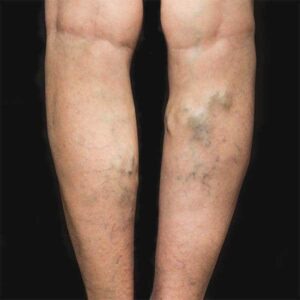What is Venous disease?
Venous disease refers to conditions that affect the veins, which are blood vessels responsible for carrying blood back to the heart. It encompasses a range of disorders that affect the veins’ ability to efficiently return blood to the heart, leading to symptoms and potential complications.
Some common types of venous diseases include:
Varicose Veins 
Varicose veins are enlarged, twisted veins that often look blue or dark purple. They tend to occur in the legs and can cause discomfort, heaviness, and swelling. Varicose veins develop when the valves within the veins weaken or fail, causing blood to pool and the veins to enlarge.
Spider Veins
Spider veins are similar to varicose veins but are smaller and closer to the surface of your skin. They often appear as red or blue clusters of veins and can cause cosmetic concerns.
Deep Vein Thrombosis (DVT)
DVT is a blood clot that forms in a deep vein, usually in the legs. It can cause swelling, pain, warmth, and redness in the affected area. DVT is a serious condition because if the blood clot breaks loose, it can travel through the bloodstream and lodge in the lungs, causing a pulmonary embolism, which can be life threatening.
Chronic Venous Insufficiency (CVI)
Chronic venous insufficiency occurs when the veins in the legs are unable to adequately return blood to the heart. It can result from conditions such as varicose veins, deep vein thrombosis (DVT), or damage to the valves within the veins. Symptoms of CVI include swelling, restless leg syndrome, pain, a feeling of leg heaviness, skin changes, and in severe cases even ulcers.
Venous diseases can be caused by various factors, genetics being the most common. Treatment for venous diseases is much easier than you might think. At BoxBar Vascular, we’re all about veins! Each day, we diagnose and treat venous issues for our patients. Have you been wondering how to take care of your vascular health? We can help.
